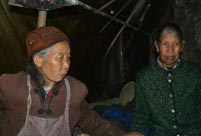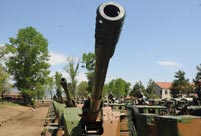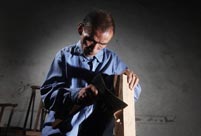

The Terracotta Warriors Museum is one of the city's major attractions. [Photo by Wang Jing/China Daily]
Feats of clay
The "Why?" behind one of the most exciting archaeological finds of the 20th century remains elusive. Did the emperor who unified China, Qin Shuhuang, fear the spirits of those he had conquered in the afterlife? Or did he simply expect to continue his rule once he'd crossed over to the other side? Whatever his motivation, the epic scale of this life-size army of soldiers, horses, chariots and wagons is so impressive that it's come to overshadow his other claim to fame: one of history's worst tyrants.
The facial features of each figure are unique and carefully detailed. The bright paint that once colored the clothing famously crumbled to dust when the warriors were excavated. Such challenges have sporadically delayed much of the digging still to be done as archaeologists seek new ways to preserve the old pigments.
Tour guides are available at the museum site. But our English-speaking group opted for a guidebook and the audio tour (40 yuan or $6.39).
The outside theater provides an interesting introduction to the making of the statues, but the filmis long and skippable if you're pressed for time.
We started with the smallest pit (No 3), where the cheesiest souvenir on the site-a digitized photo of yourself with your face cast in stone and your garb gone warrior-is surprisingly hard to resist. We ended up at Pit No 1 for an impressive finish: 6,000-plus warriors and horses lined up and ready for battle.
The site is ironically a tribute both to intense long-term planning (ancient) and to sheer dumb luck (modern). The army was only discovered in 1974 because some farmers were digging a well and came up with an imposing clay general's head. It's said the farmers got a nice chunk of change-and relocation to new housing-and the family member most credited with the find sits in the gift shop and signs books for tourists on most days.
 |  |
 J-11 fighters in air exercise
J-11 fighters in air exercise Beauties dancing on the rings
Beauties dancing on the rings Attendants-to-be join Mr. & Miss Campus Contest
Attendants-to-be join Mr. & Miss Campus Contest Beijing's toughest anti-smoking law takes effect
Beijing's toughest anti-smoking law takes effect Family lives in cave for about 50 years in SW China
Family lives in cave for about 50 years in SW China PLA soldiers operating vehicle-mounted guns in drill
PLA soldiers operating vehicle-mounted guns in drill Blind carpenter in E China's Jiangxi
Blind carpenter in E China's Jiangxi China hosts overseas disaster relief exercise for the first time
China hosts overseas disaster relief exercise for the first time 20 pairs of twins who will become flight attendants in Sichuan
20 pairs of twins who will become flight attendants in Sichuan Obama is sowing discontent in S.China Sea
Obama is sowing discontent in S.China Sea Rescuers work through night to reach cruise ship survivors
Rescuers work through night to reach cruise ship survivors Driving through limbo
Driving through limbo Facing down MERS
Facing down MERSDay|Week